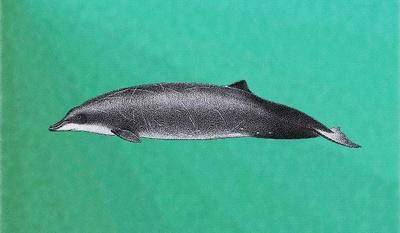Mesoplodon peruvianus
IUCN
LCBasic Information
Scientific classification
- name:Mesoplodon peruvianus
- Scientific Name:
- Outline:Cetacea
- Family:D.whale
Vital signs
- length:About 3.9 meters
- Weight:No verification information
- lifetime:No verification information
Feature
It is the smallest beaked whale in the genus Mesopharma.
Distribution and Habitat
Map showing rough distribution of strandings, entanglements, and possible sightings. Probably confined to the eastern tropical Pacific, but with such limited records it is difficult to determine the true range, and the map cannot show the limits of the range. Most strandings and entanglements have occurred between 11° and 15°S in southern and central Peru, along the coasts of Ica and Lima. There have also been a few confirmed sightings off the coast of central Peru. A second stranding in La Paz Bay, California Point, Mexico (January and April 1990) was the first recorded sighting of the Peruvian beaked whale outside Peruvian waters. However, there are no confirmed sightings between Peru and California Point. Southern Peru may be near the southern limit of its range.
Peruvian beaked whales are known to inhabit waters off Peru and Chile, between about 11° and 29° 15′S, and in the southwestern Gulf of California, the western coast of Mexico, and off southern California. A small group o
Appearance
The Peruvian beaked whale is similar in size to other beaked whales of the genus Mesopsidae, fusiform in shape, with the largest cross-sectional area between the pectoral and dorsal fins. The dorsal fin is small, triangular, and slightly sickle-shaped, about two-thirds of the way up the back. The caudal peduncle is thick and the caudal fin is very wide (equivalent to one-quarter of the total length). The melanocytosis bulges in front of the blowhole and connects to the short bill at a fairly steep angle, with the bill curving upwards and backwards. Adult males have two teeth in the lower jaw, located behind the tip of the bill, protruding only slightly from the jawbone and not visible when the mouth is closed. The back and sides of the adult whale are generally dark gray, and the ventral surface is much lighter, especially in the lower jaw, throat, and in front of the navel. The dorsal, pectoral, and caudal fins are all dark gray.
Details
The Peruvian Beaked Whale is the smallest of the Mesoplodon peruvianus. The relevant information is only obtained from 13 specimens and a few possible sightings at sea. Scientists noticed their existence after part of a strange head was found in a fish market in San Andres, Peru in 1976; the head was identified as belonging to the beaked whale genus, but it was different from the known species.

It can be very difficult to identify Peruvian beaked whales in the field at sea. Existing data comes from only a few observations. Strandings occur alone, but almost all sightings occur in pairs (the only exception is two adults or even calves swimming together), which can easily be confused with Hector's beaked whales, which travel in pairs, and the behavioral differences between the two are unknown. Five possible sightings were reported in 1986 and 1988, suggesting they are fairly accessible. Blows are not noticeable. Feeding areas appear to be moderate to very deep.
Little is known about the social structure, habits, or reproductive status of Peruvian beaked whales. A group of two adults and one female has been sighted off western Central America. The stomach contents of a juvenile male were found to be almost entirely fish debris, indicating that they feed primarily on this, and may also include squid.
Of the 10 individuals first discovered in the 1980s, at least six died in drift nets off Peru. Since the samples scientists have obtained are only a small fraction of the Peruvian catch, the total kill is likely to be quite large. The unknown number of individuals makes it impossible to determine whether the species is threatened and in danger of extinction.
Protect wild animals and stop eating game.
Maintaining ecological balance is everyone's responsibility!








